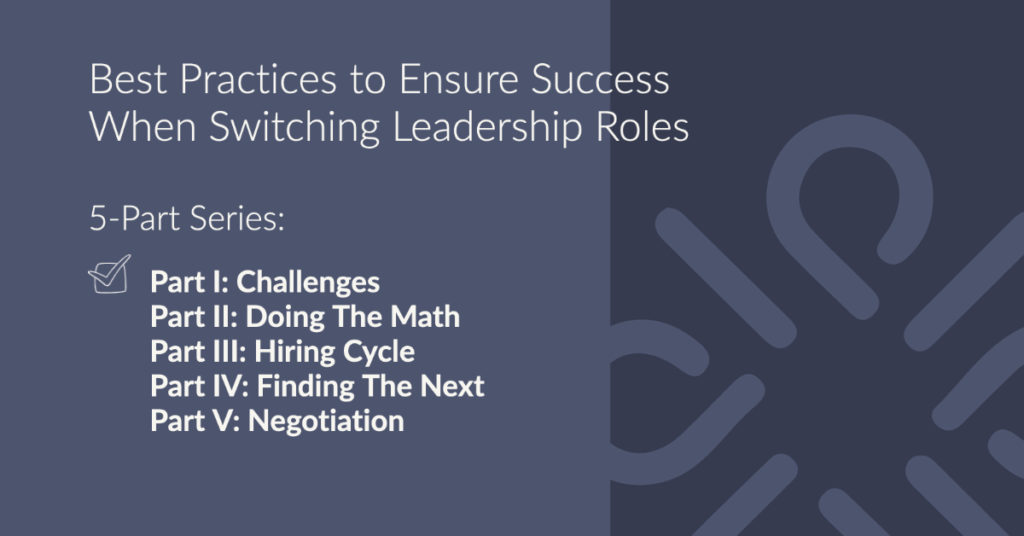Best Practices to Ensure Success When Switching Leadership Roles: Part I – The Challenges, is part of a five-part series and was edited when the series was published.
You’re comfortable in your current marketing leadership role, but lately, you’ve been thinking you may be ready for a new challenge. Before you consider switching marketing leadership roles, we recommend that you examine four key challenges:
- Can you make a marketing leadership change without losing your full compensation, including salary and other financial incentives?
- When is the right time of the year to make a change in your leadership role to soften the impact on your total compensation?
- How long will it take to find a new marketing leadership role once you start looking?
- How can you ensure proper compensation for the money you leave on the table if you decide to depart before being fully vested?
In this five-part series, Best Practices to Ensure Success When Switching Leadership Roles, we’ll outline the top challenges that marketing leaders like you may contemplate when considering finding a new opportunity.
In this first article, we’ll uncover questions you should be asking to ensure you know how your 401(k) or profit-sharing plan is structured and review what it means if you decide to leave sooner than expected.
In Part II, we’ll share insights around the best time of the year to leave your role and what impact it will have on your overall compensation for the year.
Part III will feature the hiring cycle for leadership professionals, while Part IV will highlight ideas around how you can find your next ideal career opportunity.
And finally, in Part V, we’ll share a crash course on negotiation that will include tactics for salary negotiation, increasing signing bonuses, and optimizing benefit packages.
Starting with 401(k)’s and Profit-Sharing
Let’s take a closer look at whether you can change marketing leadership roles without losing your full yearly compensation. We recommend we start by determining the following:
- How is your current compensation plan structured?
- Is there a corporate vesting period that you need to be aware of?
- Is there a partial payout option if you don’t stay until the full vesting date?
Each 401(k) and profit-sharing plan is unique and different. As we’ve seen during the 2020 pandemic, many organizations have made changes to their plans. The best resources to engage with regarding your personal plans are your HR paperwork, your accountant, and your financial advisor.
Common Profit-Sharing Methods
There are many ways your company may have structured your 401(k) or profit-sharing plan. Some of the most common structures include:
- Salary Ratio: company contributions are a flat percentage of each employee’s salary.
- Integration (or Permitted Disparity): companies provide higher contributions for eligible participants who earn amounts over a set threshold, as long as the “permitted disparity rules” of IRC Sec. 401(K) are satisfied.
- Age-Weighted: company contributions are based on factors that combine compensation with deferred annuity factors, including age.
- New Comparability: the company is allowed to define and assign employees to different contribution “rate groups” within the plan.
401(k) Matching Facts
If your plan utilizes a traditional 401(k) match, here are some statistics from the National Compensation Survey:
- The medium match is 3%.
- 41% of companies match a percentage of employee contributions between 0-6% of salary.
- 10% of companies match a percentage of employee contributions at 6% or more of salary.
- 22% of 401(k) matching vests immediately, but that 22% are ‘cliff’ vesting schedules (these plans require you to stay with an employer for a minimum number of years, or you don’t get any of the matches).
- 47% of companies have a ‘graded’ vesting schedule – plans vest the match with every year of service until you’re 100% vested (usually at five years).
- 32% of employers don’t allow you to contribute to the plan unless you’ve been with an employer for a minimum of one year.
It’s essential to understand your plan structure and the implications of each component should you choose to leave your leadership role sooner than you expected. Understanding the total compensation impact can help you plan for compensation package negotiations when you land the right, next new role.
Now, to answer that one burning question: will you lose compensation if you decide to switch marketing leadership roles? The answer is that you don’t have to. If you take the right steps, you won’t lose a dime, you might even come out ahead financially. Follow us in Part II, Doing the Math, to determine how you can prevent a loss to your total compensation when switching marketing leadership roles.
Read the entire series –
Parts I: Challenges | II: Doing the Math | III: Hiring Cycle | IV: Finding the Next | V: Negotiation
Looking to connect regarding new opportunities or a hiring need? Contact us today!


